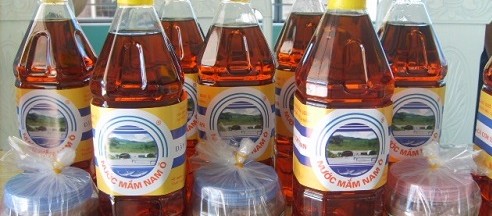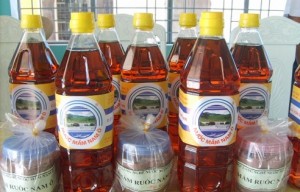Since the 19th century, making fish sauce has been the source of livelihood for Nam O Village. And in today’s modern times, Nam O residents are more determined than ever to preserve not just an income-generating business but a long-time tradition that has turned into an art and needs to be passed on for even generations to come.
Nam O Village is located at the foot of Hai Van Pass, 17 kilometers North West of downtown Da Nang City. It is a small community composed of only 5,000 residents, of which 110 households are known to practice the traditional technique of making fish sauce. The place is naturally blessed with untouched beaches and of course, a strong fishing industy.
The best fish sauce in the central region of Vietnam is made with only two main ingredients, anchovy and salt. But the secret all lies in the selection of materials and in the meticulous process of making it. The fish sauce is made on March, known as the anchovy fishing season of Nam O Village. The ratio is four kilos of salt to one kilo of anchovies. But even the salt is not just any kind, but must only come from the two major salt marsh areas of the village, Sa Huynh in Quang Ngai Province and Ca Na in Nihn Thuan Province. The fish should be nothing else but fresh because even one spoiled ingredient can equally spoil a huge volume of the finished product.
The fish is fermented along with the salt in terra-cotta or jackfruit wood jars for ten to twelve months. After which, the first drops of amber liquid will be seen to run out from a small tap at the bottom of the jar, a sign that the product can now be eaten or sold at the market. The best quality fish sauce is determined by a honey color. Nam O Village produces 100,000 liters of top-quality fish sauce from almost 200 tonnes of anchovies every year. This is equivalent to VND10 million (US$480) in profit. Each ton of fish produces 550 liters of fish sauce.
Following and proud to be using the traditional way of making fish sauce, Nam O residents undergo the whole process using manual work. The men sail out to sea to fish, while the women are assigned with the task of processing the sea products or making the fish sauce itself. Some of the fish caught are sold to the wholesalers while the rest is processed into fish sauce. They do not use any food additives or monosodium glutamate. Cleanliness is a must in the whole process to ensure safe and high-quality products.
But even though Nam O Village has been producing premium quality fish sauce for a very long time, there is a crucial need for modernization in the industry to be able to keep up with the recent and demanding times. Certain factors such as sole reliance on manual labor, outdated packaging and high price are no longer applicable in today’s highly competitive business world. The village needs a “comperehensive strategy for production, marketing and advertising.” Nam O should also diversify its production in order to create more choices for buyers.
The decline in fish sauce production in Nam O began way back in 1975 after Vietnam’s reunification. This led many villagers to look for another source of income like making firecrackers which proved to be profitable. When firecracker-making was banned in 1994, fish sauce production came back to business, but only to be halted again by the city capital’s fast urbanization. Other modern challenges that the traditional trade had to face were shortage in land for production as demand for land for resort construction rose.
But in order to keep up with the recent competition, the fish sauce association of Nam O Village is currently collaborating with companies to establish modern production facilities. In fact, Le Thi Auh Nguyet, manager of HCM City-based Tram Anh manufacturing and trading service company, has already signed a cooperation agreement with Nam O Village to invest VND2 billion (US$95,000) to build a 2,000 square meter processing facility. The new facility will create an automated production line, increasing the number of fish sauce products to 300,000 liters annually. Nguyet’s family was also into the business in the late 1980s so she is genuinely sympathetic to the plight of the villagers. She aims to make the fish sauce trademark of Nam O Village known not only in Vietnam but throughout the world.
Moreover, with the help of the local government, she foresees an expansion of the traditional business into investing in a fishing fleet, collecting the best quality anchovies and salt, packaging and design, and even doing promotional campaigns. The District People’s Committee has in fact promised to put in VND4 billion in fishing vessels to alleviate the villagers’ need to boost their catch and deliver their fish sauce products to supermarkets all over the country. Four-generation fishermen Vinh family who is also the founder of the Fish Sauce Trade Association of Nam O Village has been tasked with quality control at the new factory and is intent on maintaining the traditional recipe of making fish sauce but with modern methods with the vision of selling their products worldwide.
Along with Phu Quoc, Phan Thiet, Nha Trang and Cat Hai, Nam O Village is recognized as one of the top producers of fish sauce in Vietnam. In fact, Nam O Village has established this trademark for continuing to make top quality traditional fish sauce since the trade started centuries ago. And while the price may be a little high compared to the other fish sauce products, many consumers actually opt and patronize the village’s product because of its natural element. And it is this undying dedication to preserve the traditional way of making fish sauce that Nam O Village may be able to save the art for many more generations to come.

